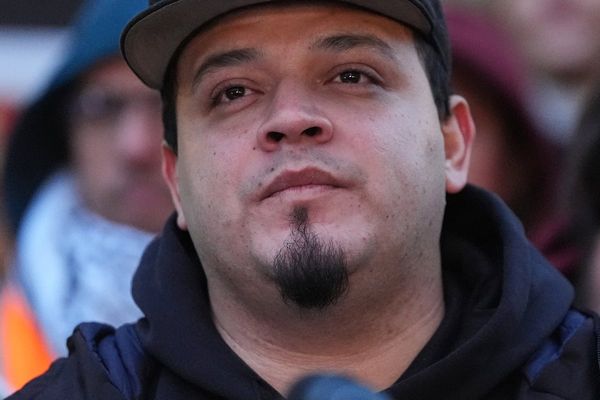
Dozens of people milled about in Philadelphia’s Love Park as a series of short film portraits played on the facade of the park’s visitor center on a recent Friday evening. The ambient sounds of the city served as a soundtrack for the silent films. Several videos played simultaneously on different sections of the 360-degree projection wrapped around the building’s exterior. Titled the Philadelphians, the 10 portraits recognize the contributions of the city’s immigrant communities.
One film profiled an Afghan immigrant named Rezwan Natiq and followed him as he shopped at a halal Middle Eastern food market. His words were displayed on the screen: “I had a lot of mixed feelings but I had no other option than to leave Afghanistan. I was thinking about my parents who stayed behind, and on the other hand, I was happy that my kids would get to live the life they deserve. At least they will be safe here.” He then shared that he felt compelled to give back to the local immigrant community after receiving the opportunity for a new life in the US.
Toward the end of the three-minute film, the words “father”, “sweetheart” and “healthcare professional” flashed over a montage of Natiq at the store and then smiling as he stood in front of City Hall. The Dari translation appeared at the bottom.
Philadelphia-based artist duo Nadia Hironaka and Matthew Suib began filming the portraits in the spring of 2024. In collaboration with the city’s Office of Immigrant Affairs (OIA), they sought to highlight the immigrant communities that have always existed in one of the oldest cities in the nation. Commissioned by Forman Arts Initiative and Mural Arts Philadelphia, the project is the result of the art non-profits’ second annual residency program where artists observed a city department. “Public art projects like The Philadelphians bring communities together and highlight how we are more alike than we are different,” Alain Joinville, the director of strategic communications and programs for the OIA said in a statement. “They are a vehicle for joy, introspection, and love.”
For Hironaka and Suib, a public artwork that recognizes the contributions of immigrants to the cultural fabric of the city may be more important now than ever. It was not meant as an overtly political project, said Suib, but as a response to negative rhetoric about immigration.
In recent months, the Trump administration has taken aim at sanctuary cities including Philadelphia, that limit cooperation with federal immigration authorities. In April, Donald Trump signed an executive order vowing to crack down on such jurisdictions. In May, Philadelphia was named on a homeland security list of hundreds of cities, states and counties at risk of losing federal funding for what the Trump administration considered obstructing immigration laws. The list was taken down a few days later, but it still encouraged Cherelle L Parker, Philadelphia’s mayor, to shirk the sanctuary label. Parker’s administration announced that Philadelphia would be called a welcoming city, though its immigration policies remain the same.
“Our focus is very much upon the intent of bringing people together, talking about shared experiences and voices and emotions and values that we have with all the immigrant communities that are here,” Hironaka told the Guardian. “You really see all of us as Philadelphians.”
The film will run until 8 June 2025, and it will be accessible online at the Mural Arts Philadelphia and Forman Arts Initiative websites afterwards.
When the artist duo learned that their residency would be based in the Office of Immigrant Affairs, which assists immigrants in resettling and accessing city services, Suib said “one of our most important cues from the office was thinking about people, not in terms of their status, but who lives in the city, who are our neighbors. They are invested in making sure that people who arrive in Philly from anywhere in the world are welcome.” Hironaka and Suib talked to everyone in the office, many of whom were immigrants themselves.
The featured participants were immigrants or descendants of immigrants from Eritrea, Ukraine, China, Jamaica, Italy, Afghanistan, Dominican Republic, Honduras, Sweden and Mexico. The films are not meant to include every immigrant community in the city, Suib said, but to highlight the community leaders and “everyday people who are just making everyday contributions to better the city through the work that they do”.
The artist duo filmed the participants using 16mm film and video at their homes, workplaces, grocery stores and places of worship. To flip “the narrative about immigrant labor to the idea of creating culture”, Suib said, they also filmed cultural craftmaking projects – such as batik, a textile dyeing technique from Asia, beadwork made by north Africans during Ramadan, and traditional African embroidery.
In the future, Hironaka and Suib hope that their project encourages other cities to engage with their diverse composite of neighbors. “It would be really nice to be a model for other cities to take on,” said Hironaka, “to conduct a similar project and reach out and connect with different immigrant communities in their cities and spaces.”
Toward the end of the Friday evening viewing, archival footage of a traditional European celebration in Philadelphia was intercut with modern-day footage of people crafting with blue beads.
The viewer was then transported to St James Church in Philadelphia, where Barbara Wilson, an immigrant from Jamaica, sat in a pew. She struggled to find a place to worship when she arrived in Philadelphia and decided to attend the church because it reminded her of one in her home country. “When someone leaves their country and comes to a new country, a country of opportunities, they want to excel,” her words appeared on the screen. “They come to help build the country and in doing so, build themselves.”







